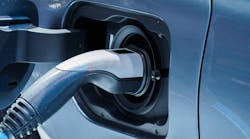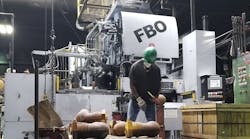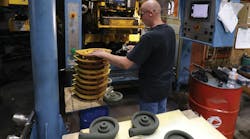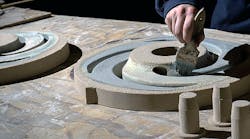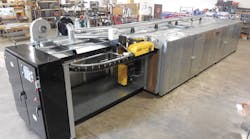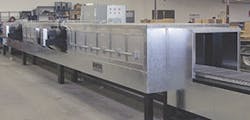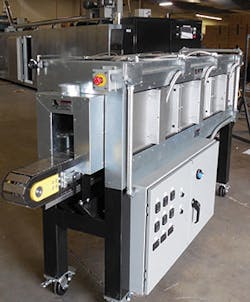The U.S. is the center of new developments in metalcasting processes, and remains among the largest markets for casting production, with U.S. casting sales forecast to top $37 billion in 2016, according to the American Foundry Society. The increasing volumes of production will almost certainly prompt metalcasters to consider new tools for production and process technology. For example, infrared heating systems address many foundries interest in better process control and production technology, preheating molds with more precision, greater speed, and superior control than traditional methods.
“Infrared is typically used to preheat molds to 150-200°C (300-400°F) to ease the flow and reduce thermal damage to the casting,” said Jesse Stricker, founder of Intek Corp., a designer and manufacturer of electric infrared heating elements and industrial ovens into which they are placed. Stricker noted that metal is usually poured at the lowest practical
temperature to minimize cracks and porosity, and pouring temperatures can vary greatly depending on the materials. For instance, zinc alloys are poured at approximately 371°C (700°F), and iron is poured at approximately 1,370°C (2,500°F.) Infrared heaters like those Intek builds can preheat molds up to 537°C (1,000°F.)
Intek is representative of the industrial trend that emphasizes efficiency and precision in the engineering of manufacturing processes, and as such its IR systems are supplanting conventional gas and electric ovens as a first choice for metalcasting operations.
The company offers custom heating elements, standard and custom industrial ovens (including refurbished ovens), conveyor ovens and even industrial space heaters. Although Intek can design and build an oven using any heat source (gas, electric and/or convection), it stands out in its application of infrared heating elements. According to Stricker, this is more than an area of specialization: it is an opportunity to enhance metalcasting customers’ processes and operating costs.
“Because an infrared heater has no moving parts and radiates so effectively, it consumes far less energy than a convection oven which requires a fan and blower,” notes Stricker. “Infrared elements can even be retrofitted to conventional gas and electric ovens for further cost-effectiveness.”
He cited one operation that saved close to $100,000 by installing customized electric infrared heating elements instead of replacing an entire gas oven. According to Stricker, most customers initially look at “standard” ovens but finally select heating products and technologies customized to their particular operation. Many foundries find that infrared heating surpasses gas and electric convection heating in terms of precision, speed, and energy savings. Aside from these advantages in mold preheating, there are economic benefits favoring the IR heating option.
Lower production costs — Given that heating plays such an important role, switching to infrared ovens yields substantial savings for any metalcaster by reducing energy consumption, but also by the reduced floor-space requirements. Gas-fired ovens generally transfer heat by convection and hence require fans or blowers, consuming a lot of energy in the process. Additional losses stem from the requirement for heating the entire oven, even for small parts. Electric convection consumes even more excessive quantities of energy to produce its heat.
In contrast, electric infrared heating elements transfer energy to the substrate of surface area via electromagnetic radiation and thus can operate in a vacuum and never come into contact with a part or material — all while generating temperatures of 537°C (1,000°F) or more.
“People assume that gas is the cheapest way to heat, but that’s not necessarily the case,” said Stricker. When considering cost it is important to include all costs, he noted: “Equipment purchase price, energy cost, installation cost, floor space required, maintenance cost, etc.”
On the other hand, electrically heated infrared elements yield as much as 86% of their input as radiant energy that strikes the surface of a product, according to the 2008 edition of the Heating, Ventilating, and Air-Conditioning Systems and Equipment Handbook. Some designs may achieve as much as 95% in the form of useable heat, with the balance being lost through the power supply lines.
“Duty cycle also factors into efficiency,” Stricker continued. “For instance, if you buy a 70-kW conventional oven and assume, for example, a 10 cents per kilowatt-hour energy consumption, that comes to $7.00 an hour. But consider how often it is actually firing and consuming energy compared to how long product is inside? Whereas, an infrared oven might only need to run at a 40% duty cycle, so heating cost would drop to $2.80 per hour in this scenario.”
Greater control — Because the amount of infrared energy varies at each wavelength, metalcasters can adjust the wavelength of electric infrared heaters to match the heat requirements of a given mold, material, or substrate in the oven for optimal performance and control. This adjustable precision can be particularly helpful for heating metal-matrix composites, which process may require some fine-tuning to achieve optimization. Infrared heating also offers very fast response times, which is beneficial when holding precise temperature uniformity.
“We are finding that one of the main reasons engineers come to us for an infrared solution is that this technology can be customized to provide exacting control for any particular component, even metal-matrix composites,” Stricker said. “Every foot in a conveyor oven path can be zoned for maximum, continuous process heating efficiency, monitored by a thermocouple in each zone.”
More flexibility — If anything sets Stricker and his team of engineers apart, it’s their ability to take advantage of one of infrared’s most useful characteristics: its adaptability. Whether used in batch ovens, walk-in ovens or conveyor systems, infrared can offer a new approach to heating.
“We made our name through our ability to apply infrared technology to a broad range of metalcasting and industrial applications,” Stricker explained. “So, a plant manager can come to us, have us check out their gas or electric ovens, then we go back to our plant to design and build an entire oven system or, as a cost advantage, to provide patented modular infrared replacement units for existing ovens which may still just need a performance upgrade. The customer participates in the design and then selects the solution. This can save tons of money.”
Electric infrared heater modules (typically sized 12x24-, 12x36-, or 12x48-inches) become structural members of the oven. They can be designed to work individually for small areas, ganged together for larger areas, or even ceiling hung or wall mounted.
“Because almost every process requires heating or drying at some point, we’re keeping very busy these days building our patented custom infrared ovens, modular heaters and elements,” said Stricker.


